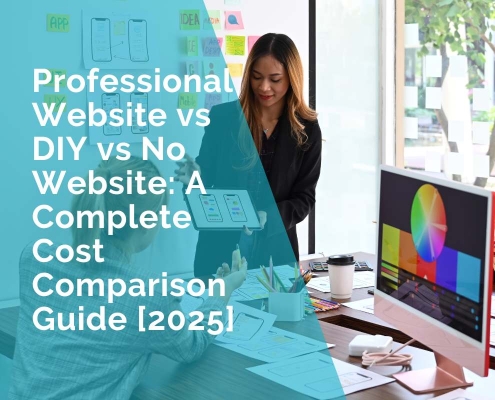Website Uptime Depends on More Than Just Hosting
When a website goes offline, the first thing most people blame is the hosting provider. And in some cases, they’re right. If the server crashes or the data centre has an outage, the problem is clearly on that side of the fence. But more often than you might think, the issue doesn’t start with the host at all.
Uptime is the result of many systems working together. Hosting is one of them, but so are the way your site is built, how it handles traffic, how quickly problems are identified, and how well third-party services perform. If any part of that chain breaks, your site can go down even if your host is doing everything right! Yikes.
This blog looks at what truly keeps a website online around the clock. Not just the server specs, but the decisions made after the site goes live. Whether you’re running a business website, an e-commerce store, or a critical internal tool, understanding what sits behind uptime is the first step to making it more reliable.
Where Hosting Ends and Responsibility Continues
Good hosting is a solid start, but even the best will have limitations and can’t take full ownership of your website’s wellbeing.
Once your site is live, what happens inside the code, plugins, and platform is primarily up to you, and chances are, your hosting provider will be charging you for any additional work.
Primarily, hosting providers focus on uptime at the infrastructure level. Their job is to ensure the server is operational, that the network connection remains live, and that their environment remains stable. However, some business owners don’t realise that they’re not monitoring how their site’s theme integrates with their plugins. They’re not testing whether your contact form breaks after the latest CMS update. And they’re not monitoring whether a third-party script is slowing your pages to a crawl.
This is where a lot of downtime quietly begins. A plugin conflict that crashes a page, a forgotten update that breaks a layout, or a misconfigured setting that spirals out of control. From the outside, the entire site appears to be down. But from the host’s perspective, everything’s running fine—it’s just your application that’s having trouble.
Code, Plugins, and Content Management Conflicts
Many websites rely on a content management system to remain flexible and easily updatable. WordPress, Joomla, and Sandhopify—they all offer plug-and-play convenience. But that convenience comes with trade-offs. When things go wrong, it’s often the code inside the site, not the hosting behind it, that causes downtime.
Poorly written themes, untested plugin combinations, and outdated extensions can all trigger issues that cause a site to go offline. Sometimes it’s an error that completely breaks the page. At other times, it’s something more subtle, such as a plugin consuming excessive server resources or conflicting with a core update in the CMS.
These issues don’t always show up immediately. A plugin might install cleanly, pass a quick test, and run fine for weeks. Then a CMS update rolls out, or another extension gets installed, and suddenly pages stop loading or the admin panel locks up. The underlying hosting hasn’t changed at all, but the user experience falls apart.
The key is maintenance. Clean code, lightweight themes, and regular compatibility checks all reduce the risk of these silent failures. Sites that are actively managed don’t just perform better—they recover faster when something goes wrong because the cause is easier to pinpoint. Uptime isn’t just about what’s running; it’s about how well the moving parts work together without conflict.
Traffic Spikes and Misconfigured Scaling
Even a well-built site on solid hosting can go down if it’s not prepared for a surge in visitors. Whether it’s a marketing campaign, a viral post, or an unexpected spike in search traffic, more users hitting your site at once can create strain. If that traffic overwhelms your setup, things slow down—or come to a complete stop.
This type of downtime often comes as a surprise to businesses. They assume that if the server is “up,” everything should be fine. However, a server can be technically online while the site it hosts becomes unresponsive. Without the proper scaling settings, caching systems, or content delivery support, your site might buckle under pressure well before the infrastructure fails.
Content delivery networks (CDNs), load balancers, and caching plugins aren’t just nice extras—they’re tools that let your site stretch without breaking. They reduce the load on your core server, spread traffic out, and serve up cached versions of pages so that every new visitor doesn’t trigger a fresh request to the same resources.
Planning for scale isn’t just about high traffic days. It’s about expecting unpredictability and giving your site the ability to adapt. A flexible, well-configured setup doesn’t just protect uptime during big moments—it helps the site run more efficiently all the time.
Monitoring and Incident Response Plans Matter
Even with the best setup, things can and will go wrong. What matters most in those moments is how quickly you find out—and how prepared you are to respond. Many businesses discover their site is down because a customer emails them, or someone on the team happens to check the homepage. By then, minutes—or hours—may have passed.
That delay can be avoided with proper uptime monitoring. These tools ping your site regularly and alert you the moment something’s off. They don’t just tell you that a page won’t load—they often flag where the slowdown or failure is happening, whether it’s a timeout, an error message, or a complete outage. That kind of immediate feedback gives you a head start on fixing the issue before it affects more users.
But detection is only part of the equation. Knowing what to do next is just as important. When every minute counts, there’s no time to guess who’s responsible or what the recovery steps should be. An incident response plan outlines who is responsible for what, who contacts support, and who pauses campaigns or updates status pages. With that clarity, response becomes faster, calmer, and more effective.
Monitoring tells you there’s a problem. A response plan makes sure the solution doesn’t take longer than the outage itself.
The Role of External Integrations and Dependencies
It’s easy to forget how many services your website relies on that live outside your server. Payment gateways, form builders, analytics scripts, and booking tools—these third-party integrations play a big part in how your site functions. However, when one of them experiences an issue, your uptime can be affected even if your server remains stable.
A payment system going offline can block transactions. A broken map widget might prevent a contact page from loading. A delayed script can cause the entire page to stall. These aren’t failures on your end, but your users experience them just the same. From their perspective, your site isn’t working, regardless of where the issue originated.
Of course, regular checks and performance audits make a difference. Identifying which external services your site depends on—and tracking how they behave—helps you spot patterns before they become disruptions. If a third-party tool is slowing things down, replacing it or loading it differently might prevent a complete outage down the track.
For many, it’s wise to have a local professional to oversee and look after the IT machine that ensures your business stays online. The best IT managed services for Australians have people based locally that understand the platforms and tools commonly used down under. Whether it’s dealing with locally hosted services, regional payment providers, or compliance-specific integrations, they bring a level of insight that speeds up both diagnosis and resolution.
A stable site isn’t just about what you host—it’s about managing everything you connect to as well.
Building a Broader Uptime Strategy
It’s tempting to treat uptime as a hosting decision: pick a reliable provider and expect the rest to take care of itself. However, keeping a site consistently online requires more than just optimal server performance. It’s the sum of how the site is built, maintained, monitored, and supported—day in, day out.
A good hosting environment provides a strong foundation, but the layers that build upon it are equally important. Clean, conflict-free code reduces the risk of internal failures. Caching and CDNs help maintain stability under load. Monitoring tools reduce the time between a problem and its resolution. And response plans turn panic into action when something goes wrong.
External tools and integrations need just as much attention. If your site relies on them to work, they need to be part of your uptime thinking. Regular reviews, smart configuration, and local support all help reduce the chances of one failing system taking everything down with it.
Treat uptime as a system, not a setting. When each layer is working well—hosting, code, traffic handling, monitoring, support—you don’t just reduce downtime. You create a site that withstands pressure and performs reliably when it matters most.
***************
LP












